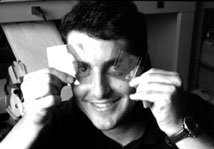Dedication
Introduction
Dan Ariely
Walter Bender
Steve Benton
Bruce Blumberg
V. Michael Bove, Jr.
Cynthia Breazeal
Ike Chuang
Chris Csikszentmihályi
Glorianna Davenport
Judith Donath
Neil Gershenfeld
Hiroshi Ishii
Joe Jacobson
Andy Lippman
Tod Machover
John Maeda
Scott Manalis
Marvin Minsky
William J. Mitchell
Seymour Papert
Joe Paradiso
Sandy Pentland
Rosalind Picard
Mitchel Resnick
Deb Roy
Chris Schmandt
Ted Selker
Barry Vercoe
Joe Jacobson
Like many of my colleagues, I feel that at the end of the day our group is interested in carrying out research that has the potential to have a positive impact on people's lives. The initial research we carried out on electronic paper was motivated, in large part, by the question of whether it might be possible to create a $10 e-book, which might come pre-loaded with something like 1,000 books. At that price, you could imagine giving one to every child on the planet.

Our work in personal fabrication is motivated by a goal of giving an individual the equivalent of a billion dollar chip, fabricated on a desktop; as well as driven by the idea of allowing a large number of people to be creative in a space—namely, that of atoms—where now very few people have the ability to play.
Much of the group's recent research is involved in creating and controlling structures at the molecular-size scale. We would like to see how close we can come towards optimizing the complexity-per-unit-volume of an engineered structure, and to create engineered structures with vast ("Avogadro Scale") numbers of parts, something we have termed Avogadro-scale-engineering. If we consider the present state of engineered, complex systems we might think of an Intel Itanium with 200 million transistors. If we consider the fact that those transistors have a feature size on the order of 100 nm, and are deployed on a two-dimensional surface, but that physics allows us to build with much smaller parts of about 1 nm in size and in three dimensions, then we actually have another factor of a million to go in technology. Recall that Moore's Law only gives us factors of 2 every 18 months. For this reason there is, understandably, tremendous interest in seeing how fast we can pick up that factor of 1 million. The current champion in complexity-per-unit volume, by far, is the molecular machinery of biology. It is for this reason that we have become very interested in being able to control and engineer such machinery. In addition to being able to squeeze vast complexity into a small space, biological machinery has an additional property that we have never had before in engineering, namely that of self-replication. Ultimately, we feel that if one can take the beautiful ideas present in molecular biology—such as self-replication—and apply them to new types of material, then that is extremely interesting.
At the end of the day I feel that helping to create an optimally interesting world is what it is all about. One of the reasons I came to MIT and to the Media Lab was because there are so many people working in so many disparate fields here; inevitably, almost every week, there is something interesting to hear about or see. Can we ever get to the point where there is something truly amazing every day? Ultimately I think the answer to that is to get as many folks as possible involved in the creative process—every person on the planet has a unique contribution to make.
In the words of Daniel Webster, "Let us ... see whether we also in our day and generation may not perform something worthy to be remembered."*
*Spoken at the entrance to the United States House of Representatives on the occasion of the dedication of the Bunker Hill Monument, 1825
First computer: I had a Sinclair first, and some homebrews, but the most important was an Apple II. The instruction manual came with full schematics!